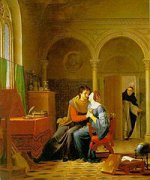|
 Peter (Pierre) Abelard, was a prominent medieval French philosopher, logician, theologian, and monk. While still in his teens he challenged and defeated a major school of medieval thought known as Realism. By age twenty-two he established his own school and was a gifted and popular teacher. His philosophy of Conceptualism became the favored philosophic theory of the period. Abelard found the stresses of teaching and heated competition between other philosophers to be taxing, yet each time he took a break from it and returned, his ideas always triumphed. Around the year 1112 he undertook the study of theology at Laon. His intellect was immediately recognized and soon moved from student to lecturer. By 1115 he assumed the chair of theology at Notre-Dame. His intellect, regal bearing, and polite manners attracted thousands of adoring students, who crowded his lectures and followed him around Paris. At this point he reached the height of his success. Dedicated to philosophy, science, and education, his life path seemed clear, his future bright. What he did not count on was romance. Peter (Pierre) Abelard, was a prominent medieval French philosopher, logician, theologian, and monk. While still in his teens he challenged and defeated a major school of medieval thought known as Realism. By age twenty-two he established his own school and was a gifted and popular teacher. His philosophy of Conceptualism became the favored philosophic theory of the period. Abelard found the stresses of teaching and heated competition between other philosophers to be taxing, yet each time he took a break from it and returned, his ideas always triumphed. Around the year 1112 he undertook the study of theology at Laon. His intellect was immediately recognized and soon moved from student to lecturer. By 1115 he assumed the chair of theology at Notre-Dame. His intellect, regal bearing, and polite manners attracted thousands of adoring students, who crowded his lectures and followed him around Paris. At this point he reached the height of his success. Dedicated to philosophy, science, and education, his life path seemed clear, his future bright. What he did not count on was romance.
Abelard is best and in many cases, only remembered today for his intense and ultimately tragic romance with a young woman named Heloise. Credited not only with beauty, she was intelligent and well educated in Latin, Greek, and Hebrew. She was the uncle – and perhaps daughter – of a local canon named Fulbert, with whom she lived. Abelard was immediately attracted and increasingly sought ways to spend time at Fulbert’s home. He became tutor to Heloise and the two fell into a passionate love affair, which was not kept secret even by Abelard himself. Apparently Fulbert was the last to know, but when he discovered the nature of the relationship he kept the two lovers separate. Heloise and Abelard continued to meet secretly and she soon became pregnant. Abelard sent her to Brittany to stay with members of his family. She gave birth to their son, whom she named Astrolabe (after the scientific instrument). Back in Paris, Fulbert remained angry, and Abelard suggested he marry Heloise secretly, so that his church career could continue. While lecturers and philosophers were not bound by priestly vows of chastity, at the time it was considered poor form for academics to marry. Heloise vehemently opposed the marriage, as she wished to remain an independent woman. Eventually she agreed to marry, but Fulbert did not keep the marriage a secret. However, Heloise denied the marriage had taken place and was then treated so poorly by her uncle and others that she left the city to live in a convent. Fulbert became even more angry and blamed Abelard for assisting Eloise in running away. The irate uncle interpreted the couple’s actions as Abelard’s way of ridding himself of an unwanted lover. Fulbert and others working for him exacted their revenge by breaking into Abelard’s home at night and castrated him. With such an act committed against him, Abelard was thus banned from teaching and from the priesthood. He became a monk, and Heloise became a nun, but only at the insistence of Abelard.
Gradually Abelard returned to study and eventually opened a school where he lectured regularly. However, he still had many enemies, and at 1121 he was forced to burn his own book of philosophy and named a heretic. He and Heloise continued to correspond for the rest of their lives. Initially their letters were of a more romantic nature, but after Abelard advised Heloise that he had never loved her but only lusted after her, their letters take on a more formal tone, though evidence of Heloise’s fiery spirit continues to appear in her letters.
Abelard’s later years were plagued with further controversy and plots against him by enemies from the church. When he died in 1163 his remains were buried and then removed to the Paraclete Convent, where Heloise was Abbess, and where she was later buried beside him.
Image: "Abaelard and Heloïsa, surprised by Master Fulbert" by Jean Vignaud, 1819.
|